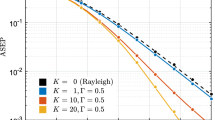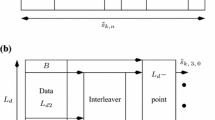Abstract
A simple DPSK receiver for the linearly frequency-selective fading channel is presented. The channel is modelled as an f-power series truncated to the first two terms [1], [2]. Two specifically designed time invariant filters are used to remove the channel-induced ISI and separate the two implicit diversity branches. The received samples from each filter are then differentially decoded and linearly combined. Analytical and simulation results for binary DPSK demonstrate that this receiver shows significant improvement over the conventional receiver, which uses matched filtering and a product demodulator.
Similar content being viewed by others
REFERENCES
P. A. Bello, “Characterization of Randomly Time-Variant LinearChannels, ” IEEE Trans. Commun. Sys., Vol. 11, pp. 360–393, Dec. 1963.
W. S. Leon, U. Mengali, and D. P. Taylor, “Equalization of Linearly Frequency Selective Fading Channels, ” IEEE Trans. Commun., Vol. 45, pp. 1501–1503, Dec. 1997.
J. G. Proakis, Digital Communications, 3rd ed., McGraw Hill, New York, 1995.
W. Liu and P. Ho, “Differential Detection of PSK Signals in Frequency Selective Rayleigh Fading Channel, ” Proc. GLOBECOM, Orlando, Florida, 1992, Vol. 2, pp. 1802–1806.
D.-W. Jang, S.-K. Oh, and Y.-H. Lee, “Decision Feedback Demodulation-based Adaptive Linear Equalisers for Differentially Coherent DPSK Systems, ” Electronics Lett., Vol. 32, pp. 1851–1852, Sept. 1996.
A. Masoomzadeh-Fard and S. Pasupathy, “Nonlinear Equalization of Multipath Fading Channels with Noncoherent Demodulation, ” IEEE J. Select. Areas Commun., Vol. 14, pp. 512–520, Apr. 1996.
W. C. Dam and D. P. Taylor, “An Adaptive Maximum Likelihood Receiver for Correlated Rayleigh Fading Channels, ” IEEE Trans. Commun., Vol. 42, pp. 2684–2692, Sept. 1994.
L. Bin and P. Ho, “A New Decision-Feedback DPSK Receiver with filters Blind Phase Prediction, ” Proc. GLOBECOM, Vol. 1, pp. 337–341, Phoenix, Arizona, 1997.
F. Adachi, “Adaptive Differential Detection Using Linear Prediction for M-ary DPSK, ” IEEE Trans. Veh. Technol., Vol. 47, pp. 909–918, Aug. 1998.
P.Y. Kam, “Bit Error Probabilities of MDPSK over the Nonselective Rayleigh Fading Channel with Diversity Reception, ” IEEE Trans. Commun., Vol. 39, pp. 220–224, Feb. 1991.
D. Noneaker and M. Pursley, “M-ary Differential Phase-Shift Keying with Diversity Combining for Communications over a Doubly Selective Fading Channel, ” Proc. Int. Conf. Commun., Vol. 1, pp. 302.5.1–5, Chicago, 1992.
B. Hart and D. P. Taylor, “Extended MLSE Diversity Receiver for the Time-and Frequency-Selective Channel, ” IEEE Trans. Commun., Vol. 45, pp. 322–333, Mar. 1997.
G. Deng, J. Cavers, and P. Ho, “A Reduced Dimensionality Propagation Model for Frequency Selective Rayleigh Fading Channels, ” Proc. Int. Conf. Commun., pp. 1158–1162, Seattle, 1995.
W. S. Leon and D. P. Taylor, “MLSE Receiver for the Dispersive Rayleigh Fading Channel, ” Proc. Int. Conf. Commun., Vol. 3, pp. 1513–1517, Montreal, Canada, June, 1997.
G. M. Vitetta, D. P. Taylor, and U. Mengali, “Double-Filtering Receiver for PSK Signals Transmitted over Rayleigh Frequency-Flat Fading Channels, ” IEEE Trans. Commun., Vol. 44, pp. 686–695, June, 1996.
G. M. Vitetta, U. Mengali, and D. P. Taylor, “Differential Detection of PSK Signals Transmitted over Linearly Time-Selective Rayleigh Fading Channels, ” Proc. Int. Conf. Commun., Vol. 1, pp. 433–437, Atlanta, Georgia, 1998.
S. Haykin, Communication Systems, 3rd ed., John Wiley and Sons, New York, 1994.
W. C. Jakes Jr., Microwave Mobile Communications, JohnWiley & Sons, New York, 1974.
M. Schwartz, W. R. Bennett, and S. Stein, Communication Systems and Techniques, McGraw-Hill, New York, 1966.
M. J. Barrett, “Error Probability for Optimal and Suboptimal Quadratic Receivers in Rapid Rayleigh Fading Channels, ” IEEE J. Select. Areas Commun., Vol. 5, pp. 302–304, Feb. 1987.
D. Verdin and T. C. Tozer, “Generating a Fading Process for the Simulation of LandMobile Radio Communications, ” Electronics Lett., Vol. 29, No. 23, pp. 2011–2012, Nov. 1993.
N. J. Baas and D. P. Taylor, “Bandwidth Expansion for Robust, Low-Complexity Communication over Fading Dispersive Channels, ” IEEE Trans. Commun., Vol. 49, pp. 1748–1754, Oct. 2001.
A. Papoulis, Probability, Random Variables, and Stochastic Processes, 3rd ed., McGraw-Hill, New York, 1991.
Author information
Authors and Affiliations
Corresponding author
Rights and permissions
About this article
Cite this article
Leon, W.S., Taylor, D.P. DPSK Receiver with Implicit Diversity for the Linearly Frequency-Selective Rayleigh Fading Channel. International Journal of Wireless Information Networks 9, 275–286 (2002). https://doi.org/10.1023/A:1021056029878
Issue Date:
DOI: https://doi.org/10.1023/A:1021056029878




